The NFL playoffs are finally here. Will Patrick Mahomes pull a Greg Jennings and put this more flawed than usual version of the Chiefs on his back? Can Joe Burrow be elite enough to win four straight games into February? Will Tom Brady vs. Aaron Rodgers give us a different result in 2022?
These storylines are fine and dandy, but they also reflect the reality that quarterbacks are valued above all else when it comes to the glorious pastime known as American football. This isn’t to suggest quarterbacks aren’t the most important position in football; signal-callers accounted for the first 23 spots in PFF’s WAR rankings for the 2021 regular season. Still, football is a team game; largely ignoring the rest of the squad in favor for each team’s high-profile quarterback doesn’t tell the whole story.
What follows is an attempt to figure out who is the playoff field’s most-complete team. For the love of God, please don’t confuse this with a power ranking or who I believe is the best overall squad. Again: Quarterbacks deserve to be valued more than their peers; this article attempts to show league hierarchy if we remove this constant.
Click here for more PFF tools:
Rankings & Projections | WR/CB Matchup Chart | NFL & NCAA Betting Dashboards | NFL Player Props Tool | NFL & NCAA Power Rankings | Best Bets Tool
On offense we'll look at:
- Pass Offense: Rank of average of each team's ranks in EPA per pass, yards per attempt, explosive pass-play rate, adjusted completion rate and PFF pass offense team grade
- Run Offense: Rank of average of each team's ranks in EPA per run, yards after contact per attempt, explosive run-play rate and PFF run offense team grade
- Offensive line: Rank of average of each team's ranks in yards before contact per rush, pressure rate allowed and PFF run as well as pass blocking team grade
- Receiving: Rank of average of each team's ranks in yards after the catch per reception, drop rate, yards per route run and PFF receiving team grade
And defense:
- Pass Defense: Rank of average of each team's ranks in EPA allowed per pass, yards allowed per attempt, explosive pass-play rate allowed and PFF coverage team grade
- Run Defense: Rank of average of each team's ranks in EPA allowed per run, explosive run-play rate allowed, yards before contact per carry allowed and PFF rush defense team grade
- Havoc: Rank in: (tackles for a loss and for no gain + forced fumbles + interceptions + batted pass and deflections + pressures) / plays
- Tackling: Rank of average rank in missed tackle rate, yards after contact per carry allowed and yards after the catch per reception
One limitation of this study is the fact that I averaged ranks, so a massive difference between the No. 1 and No. 2 team will be treated the same as a small difference. Additionally, strength of schedule wasn't actively accounted for. Coaching also obviously plays a massive role in any football game. Finally, all these categories were weighted equally. Again: The goal here is to provide a different sort of breakdown than simply ranking the quarterbacks and moving on. I tried to control for some of these limitations by using multiple metrics for each category while also favoring efficiency over volume.
The following chart denotes each team’s rank in the aforementioned metrics and is sorted by each team’s cumulative average of said ranks.
Averaged efficiency ranks of multiple stats in eight different categories to get a rough idea of the "most complete" NFL playoff team.
QB weighted same as run defense; please don't freak out. Just a different way to show every team's holes on both sides of the ball. Cool? Cool. pic.twitter.com/smAKHi8Mrg
— Ian Hartitz (@Ihartitz) January 11, 2022
Please don’t interpret this as a contendership ranking; the Buccaneers and Chiefs were fourth and ninth in this study last season. Still, football games are ultimately contested between 52-man rosters, so we should make an effort to evaluate more than just the ever-important quarterback position. More information on each individual team’s biggest strength and weakness on offense and defense is below.
No. 1: San Francisco 49ers
Biggest offensive strength: Only the Bengals put together a more efficient overall passing game than Jimmy Garoppolo and company this season. Overall, the 49ers ranked as a top-six offense in EPA per pass play (No. 6), yards per attempt (No. 2), adjusted completion rate (No. 5) and explosive pass play rate (No. 1). Of course, this wasn’t achieved in the grandest style: Jimmy G’s average target depth of 7.8 yards ranks 30th among 44 quarterbacks with at least 100 dropbacks this season. Still, teams don’t get more real life points or yards based on flair; good luck containing each of George Kittle, Deebo Samuel and Brandon Aiyuk on any given Sunday.
Biggest offensive weakness: The 49ers’ rushing attack rather surprisingly comes in as their biggest weakness. Still, they come in as the league’s 11th-ranked group, speaking to their overall completeness and serving as a testament to their top-overall ranking in this study. The league’s 17th ranked offense in EPA per run play, San Fran does deserve some slack for dealing with all sorts of injuries to their running back room throughout 2021. Good thing Elijah Mitchell is ready to go for the playoffs: The rookie averaged a robust 4.7 yards per carry on the season and didn’t record a single drop or fumble on 226 touches — the most touches in the NFL without one.
Biggest defensive strength: Nobody has allowed fewer yards before contact per carry than the 49ers this season. You’d be hard pressed to find a meaningful rushing defense efficiency metric that paints this group as anything other than elite. The group is highlighted by Nick Bosa (PFF’s seventh-highest-graded edge), but the likes of Arik Armstead (12th-highest-graded interior defender), D.J. Jones (18th) and (especially) LB Fred Warner (13th-highest-graded linebacker) make this entire front-seven a nightmare for opponents to deal with.
Biggest defensive weakness: The 49ers rank just 15th in EPA per pass play largely because of their rather mediocre cornerback room:
- Emmanuel Moseley: 69.7 PFF coverage grade (No. 30 among 134 qualified corners)
- Dontae Johnson: 63.0 (No. 65)
- K’Waun Williams: 60.8 (No. 79)
- Deommodore Lenoir: 58.8 (No. 90)
- Josh Norman: 47.4 (No. 124)
- Ambry Thomas: 47.1 (No. 125)
Containing Bosa and company up front long enough to attack these corners is probably the best path to success for NFC offenses of all shapes and sizes.

No. 2: New England Patriots
Biggest offensive strength: New England generally didn’t ask its passing game to do much; they ranked 28th in pass play rate in non-garbage time situations this season. And yet, the group was efficient when asked to perform: Jakobi Meyers headlined this top-six group of pass-catchers in PFF receiving grade (No. 6) and yards per route run (No. 4). No team posted a lower overall drop rate; credit to all parties involved on generally making the most out of their limited opportunities.
Biggest offensive weakness: Mac Jones was the league’s best rookie quarterback; just realize this was relative to a bunch of first-year signal-callers who otherwise ranked outside the league’s top-30 talents in most passing metrics. Jones was just the league’s 22nd-ranked quarterback in adjusted completion rate (74.7%) and ranked 19th in big-time throw rate (4.2%). The passing game as a whole still comes in as the league’s 11th-best unit in this study; this group being a “weakness” is a testament to how complete the Patriots happen to be.
Biggest defensive strength: This pass defense lost Stephon Gilmore and barely skipped a beat. Overall, the Patriots ranked as one of the league’s top-six defenses in PFF coverage grade (No. 3), EPA allowed per pass play (No. 5), yards per attempt (No. 4) and explosive pass play rate (No. 6). No. 1 CB J.C. Jackson (PFF’s sixth-highest-graded corner in coverage) deserves plenty of credit, but there’s plenty of help elsewhere in this secondary, thanks to safeties Adrian Phillips (PFF’s seventh-highest-graded safety), Devin McCourty (No. 15) and Kyle Dugger (No. 26). Dak Prescott and Josh Allen led the only two passing games to clear 300 passing yards against this defense all season.
Biggest defensive weakness: The Patriots rank just 13th in havoc. Again: not terrible by any stretch; this is one helluva defense. The issue doesn’t have much to do with the group’s aforementioned pass defense; New England ranks highly in both pressure (seventh) and total interceptions (26, second). Rather, this defense has only forced nine fumbles all season — tied for the 25th-highest mark in the league. They also come in as a bottom-seven defense in total tackles for a loss or no gain; Matthew Judon and company will need to bring their A-game and cause more problems than usual for this defense to be at their very best when it matters most.
Related content for you:
2021-22 NFL Playoffs Betting Guide: Best spread, moneyline and futures bets via Eric Eager and Ben Brown
No. 3: Green Bay Packers
Biggest offensive strength: Having a great overall passing game makes for a bit of a chicken or the egg situation between the quarterback and receivers. Either way, this Packers’ aerial attack was nothing short of masterful in 2021, posting top-seven ranks in PFF receiving grade (No. 3), yards after the catch per reception (No. 3), yards per route run (No. 7) and drop rate (No. 2). Obviously, Davante Adams was the alpha of the group; he finished the season as the league’s third-best wide receiver in yards per route run (min. 25 targets):
- Cooper Kupp (3.12)
- Deebo Samuel (2.98)
- Adams (2.82)
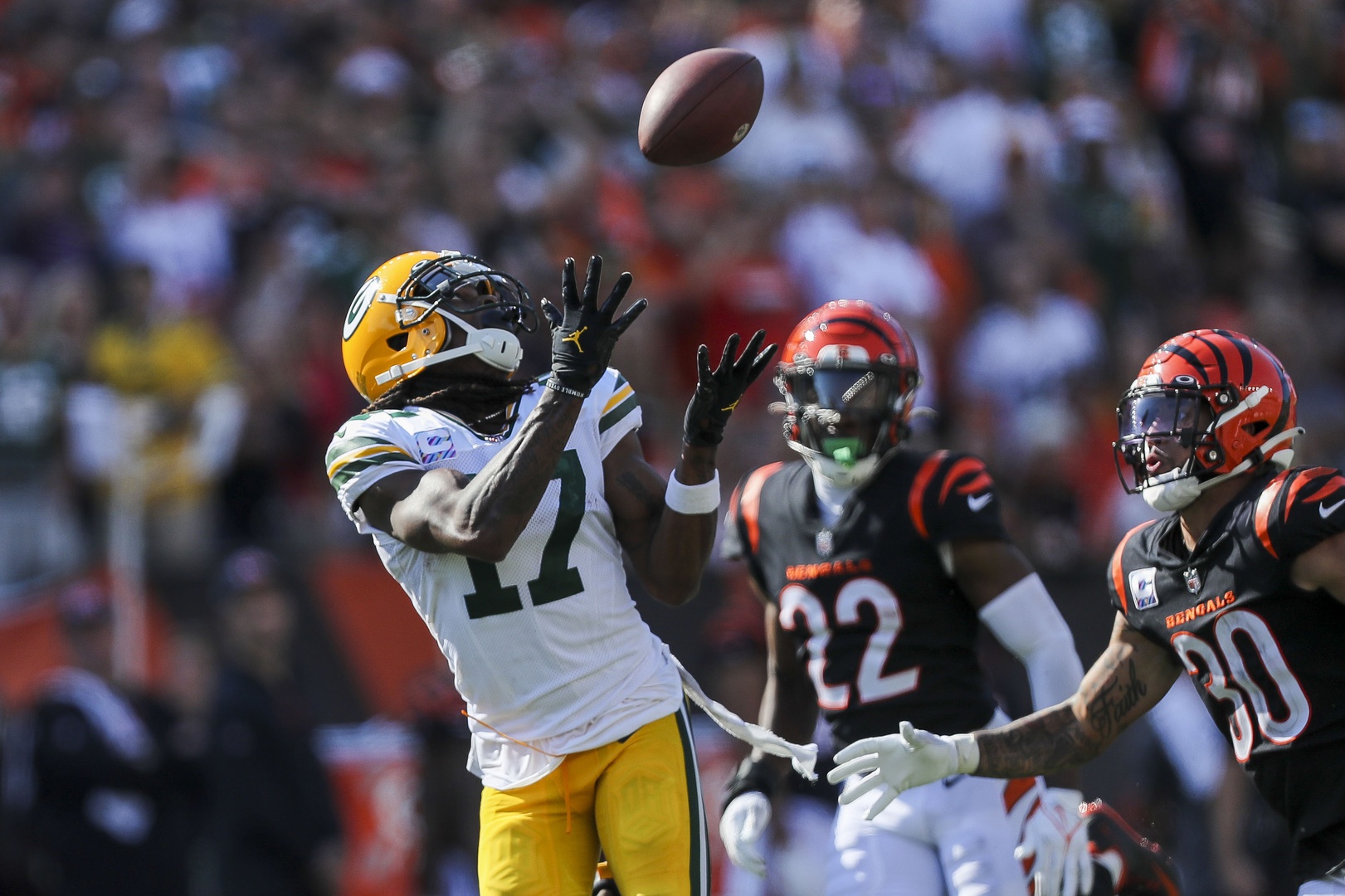
Biggest offensive weakness: This offensive line is getting back All-Pro LT David Bakhtiari at the right time. The Packers’ group of big uglies wasn’t terrible this year, but it struggled to get consistent push up front and posted mediocre ranks in PFF run-blocking grade (No. 23) and yards before contact per attempt (No. 27). Luckily, A.J. Dillon provided plenty of juice throughout the season: He gained at least 2.0 yards after contact on a league-high 78% of his carries.
Biggest defensive strength: The Packers come in as the league’s fifth-best defense in our pass and havoc categories. We’ll ride with the former as the key strength considering the secondary should only get better with the return of all-world CB Jaire Alexander. Either way, credit to everyone involved for posting top-10 marks in PFF coverage grade (No. 7), EPA allowed per pass play (No. 9), yards per attempt (No. 5) and explosive pass play rate (No. 4) on the season.
Biggest defensive weakness: A familiar issue for this group, run defense continued to be more meh than good and limped to bottom-12 finishes in both yards before contact allowed per carry (No. 23) as well as EPA allowed per run play (No. 29). Once again: Help is on the way at the right time, this time in the form of edge Za’Darius Smith. It’s safe to say the Packers offer the largest improvement ahead of the postseason in terms of overall roster health.
No. 4: Tampa Bay Buccaneers
Biggest offensive strength: Credit to PFF’s single-best offensive line in team pass-blocking grade, but Tom Brady is obviously the straw that stirs the league’s second-ranked scoring offense. PFF’s leader in WAR and a more than reasonable MVP pick, Brady finds himself atop the leaderboard in more passing statistics than not this season at the ripe age of 44:
- PFF passing grade: 91.5 (No. 1 among 44 qualified quarterbacks)
- QB rating: 102.1 (No. 9)
- Passing yards: 5,316 (No. 1)
- Yards per attempt: 7.4 (tied for No. 13)
- Adjusted completion rate: 76.4% (No. 16)
- Passing touchdowns: 43 (No. 1)
- Big-time throw rate: 5.7% (No. 12)
- Turnover-worthy play rate: 1.9% (No. 2)
Biggest offensive weakness: This rushing attack ranked just 15th in EPA per run play and 25th in explosive run play rate. That was with more healthy games than not from the likes of Leonard Fournette (hamstring), Ronald Jones (ankle) and Giovani Bernard (hip); it remains possible this running back room is headlined by Le’Veon Bell and Ke’Shawn Vaughn during the most important moments of the season.
Biggest defensive strength: Nobody wreaked more consistent havoc than the Buccaneers this season. Edge Shaquil Barrett (PFF’s 12th-highest-graded edge) deserves plenty of credit, but recently #paid interior defender Vita Vea (18th) also had himself one helluva season. Tampa Bay ranked sixth in overall pressure rate and eighth in quick pressure rate (under 2.5 seconds); finding success against this defense is first and foremost predicated on at least containing this stud-filled front-seven.
Biggest defensive weakness: Only the Lions posted a worse rate of missed tackles than the Buccaneers this season. This went hand in hand with Tampa Bay ranking 27th in yards after contact allowed per carry; sometimes there’s a price to pay for being so aggressive at all three levels of the defense. This front-seven sure could use Lavonte David (foot, IR) back: His status as PFF’s 14th-best linebacker in tackling grade makes him the Buccaneers’ only player at the position ranked inside the top-65.
No. 5: Los Angeles Rams
Biggest offensive strength: Matthew Stafford and company ranked second in EPA per pass play this season, trailing only the Chiefs. Of course, Cooper Kupp deserves all sorts of credit for this accomplishment. 2021’s fantasy MVP, Kupp just pulled off one of the best seasons in recent memory on his way to functioning as the first receiving triple-crown winner since Steve Smith. He accomplished this about as efficiently as one could hope for, as the first-team PFF All-Pro wide receiver joined Julio Jones as the only receivers to average at least 3.0 yards per route run in a single season over the past 10 years.
Biggest offensive weakness: The likes of Sony Michel and Darrell Henderson provided some fantasy goodness throughout the season thanks to their strangleholds on the backfield’s volume during their respective runs as the team’s undisputed three-down back. Still, the team as a whole ranked just 28th in yards after contact per carry. The only offenses that posted a lower EPA per run play: Dolphins, Falcons, Texans and Raiders. Not great, Sean.
Biggest defensive strength: PFF’s single-best defense in team grade against the run, Aaron Donald and company generally made life a living hell for rushing attacks throughout 2021. They ranked seventh in average depth of tackle at 3.84 yards and held their opponent under 100 rushing yards on nine separate occasions throughout the year.
Biggest defensive weakness: Obviously, Jalen Ramsey holds up his end of the bargain during any given week, but at the end of the day, the Rams fielded just the league’s 15th-best defense in PFF coverage grade and 20th-ranked group in yards per attempt allowed. Don’t expect Ramsey to follow Christian Kirk around the formation come Sunday; only Davante Adams, Mike Evans, D.K. Metcalf and Justin Jefferson have earned shadow treatment from the Rams’ No. 1 corner over the past two seasons.
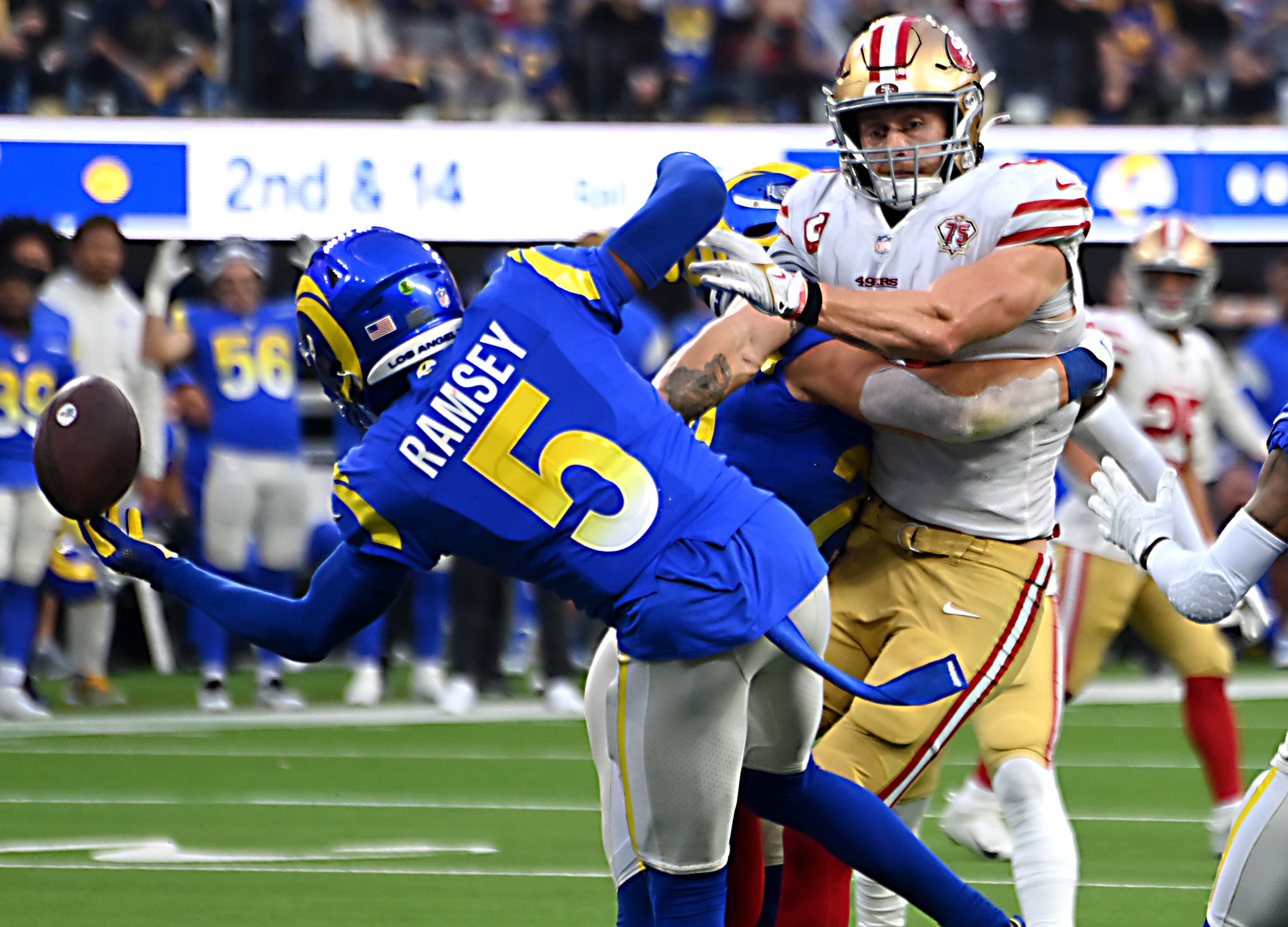
No. 6: Dallas Cowboys
Biggest offensive strength: There might not be a better offensive line in the league when LT Tyron Smith is fully healthy and on his A-game. Overall, the Cowboys ranked first and second in run- and pass-blocking grade, nearly joining the 2020 Browns as the only offensive lines to finish first in both metrics in PFF’s history (since 2006).
Biggest offensive weakness: The league’s top-ranked scoring offense understandably doesn’t have too much of a weakness. Still, the rushing attack comes in as “just” the league’s 12th-best unit. It’s fair to wonder how much better this group would have ranked out had Tony Pollard been used over a banged-up version of Ezekiel Elliott throughout the second half of the season.
Running back yards after contact per carry and missed tackles forced per carry (min. 100 carries, PFF) pic.twitter.com/RoPO5zcEOM
— Ian Hartitz (@Ihartitz) January 10, 2022
Biggest defensive strength: Only the Buccaneers and Bills wreaked more consistent havoc than the Cowboys this season, mainly thanks to their trio of studs across the front-seven. Overall, each of Micah Parsons (93.0 PFF pass-rushing grade, No. 1), Randy Gregory (84.4, No. 18) and Demarcus Lawrence (81.3, No. 25) finished among PFF’s top-25 pass rushers out of everyone with even 50-such snaps this season. This sort of consistent pressure allows Trevon Diggs and company to take chances in the back end: only the Bills defense allowed a lower passer rating against quarterbacks who were forced to get rid of the ball in 2.5 or fewer seconds.
Biggest defensive weakness: This run defense was rather rough throughout 2021, ranking 30th in yards before contact allowed per carry and 27th in EPA allowed per run play. They allowed at least 100 rushing yards in 11 of their final 12 games; this could be problematic against a well-schemed rushing attack like the 49ers.
No. 7: Buffalo Bills
Biggest offensive strength: The Bills rank 30th in run-play rate in non-garbage time situations; Josh Allen and the passing game are usually leaned on early and often. Still, the offense was awfully effective at running the ball when it wanted to, emerging as one of just seven offenses to post a positive EPA per run play:
- Eagles (+0.07 EPA per run play)
- Colts (+0.06)
- Browns (+0.06)
- Seahawks (+0.04)
- Bills (+0.04)
- Ravens (+0.02)
- Chiefs (+0.01)
Biggest offensive weakness: Stefon Diggs had himself another largely excellent season, but this group of receivers as a whole ranked as below-average in drop rate (16th), yards per route run (19th) and especially yards after the catch per reception (32nd). The latter metric could feasibly be boosted if the team felt more confident in its younger backups; Isaiah McKenzie (3.8 yards after the catch per reception) and Gabriel Davis (3.9) proved to be plenty capable with the ball in their hands when Cole Beasley (3.8) and Emmanuel Sanders (2.3) missed time. How this wide receiver room shakes out is one of the bigger fantasy storylines ahead of the 2022 offseason.
Biggest defensive strength: This defense isn’t quite the same without baller CB Tre’Davious White (ACL, IR) on the field, but that didn’t stop them from ranking first in literally every pass-defense metric considered. Somehow, this group only allowed 12 passing touchdowns all season, joining the Rams and Patriots as the league’s only three defenses to have more interceptions than passing scores allowed.
Biggest defensive weakness: Jonathan Taylor, Damien Harris and others showed the best path to moving the ball against this defense is by trying to physically ram it down their collective throats. Overall, the Bills struggled in all three of the tackling categories considered: missed tackle rate (16th), yards after contact allowed per carry (No. 20) and yards after the catch allowed per reception (No. 21). Tremaine Edmunds is still just 23 years old, but he might need to grow up in a hurry to help this group of linebackers: Edmunds (No. 17) is the only linebacker on the Bills ranked higher than 40th in PFF tackling grade.
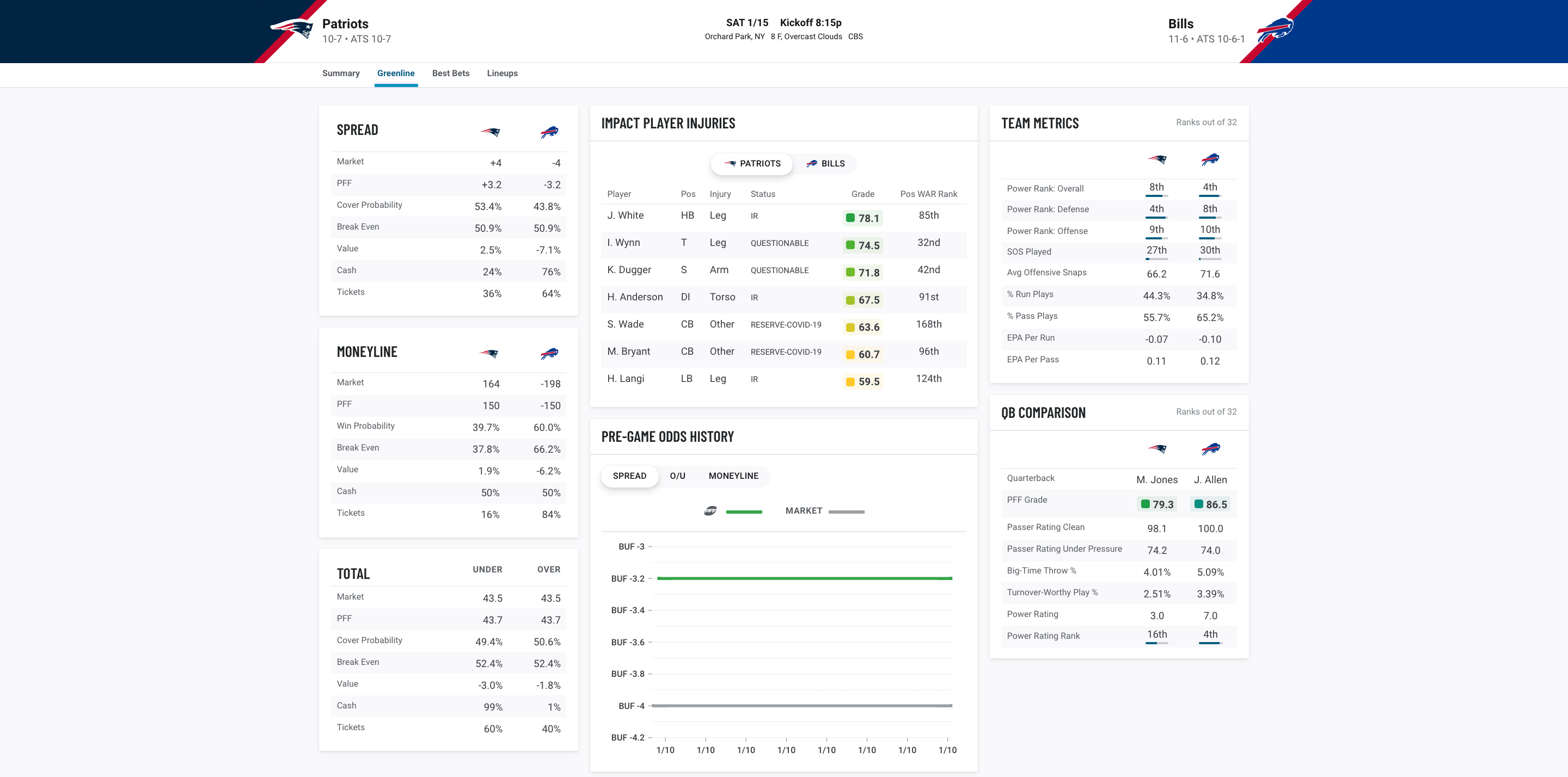
No. 8: Philadelphia Eagles
Biggest offensive strength: This offensive line made the Eagles’ decision to morph into the league’s most run-heavy offense a reasonable one. Overall, this group ranked fifth and seventh in team run- and pass-blocking grade. Nobody averaged more yards before contact per carry on the season. Obviously having a dual-threat quarterback like Jalen Hurts under center helps widen some rushing lanes in the read option game; just realize three of the team’s five starting linemen managed to rank inside PFF’s top-12 overall players at their respective position.
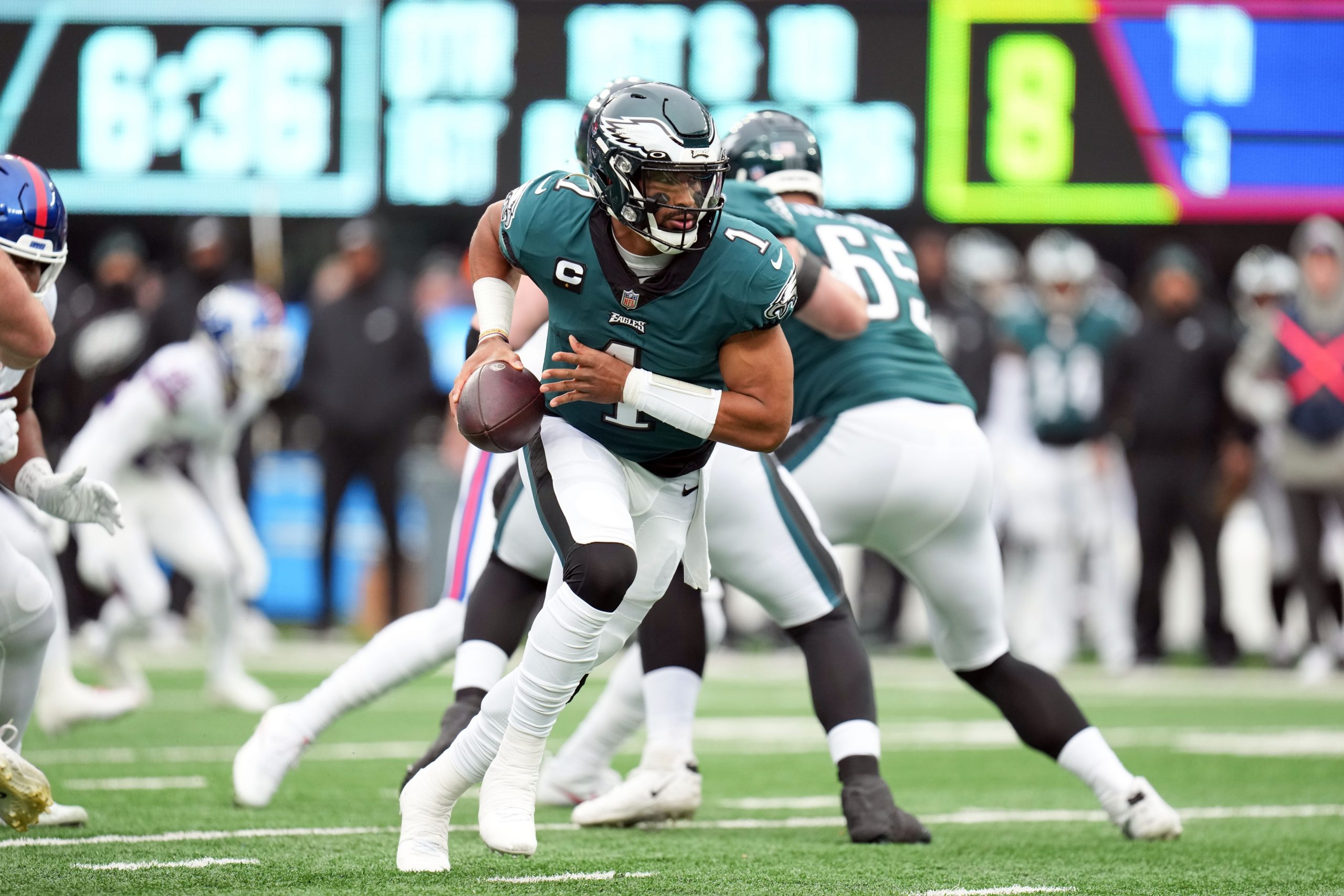
Biggest offensive weakness: Devonta Smith flashed on numerous occasions during his first season as a professional, but this group ultimately ranked 19th in PFF receiving grade, 18th in yards per route run and 24th in drop rate. Only Dallas Goedert (90.0), Lane Johnson (89.0, lol) and Smith (76.6) managed to post a PFF receiving grade north of 75.0; it’s tough to name a worse starting receiver than Jalen Reagor at the moment.
Biggest defensive strength: Only the Football Team and Patriots posted a lower missed tackle rate than the Eagles this season. They were also excellent at limiting big plays after the catch, ranking fifth in yards after the catch per reception. Don’t let the Cowboys’ 51-point outburst in Week 18 distract from the fact that this group has previously allowed 18 or fewer points in five consecutive games.
Biggest defensive weakness: This group simply didn’t make a habit of making their presence felt in their opponent's backfield. Their status as the 11th-ranked defense in pressure rate is far from bad, but they converted pressures into sacks at the league’s second-lowest rate (14.6%). This was a below-average defense in total tackles for a loss or for no gain; creating more negative plays than usual will be essential in order to pull off the upset against the defending champs.
No. 9: Cincinnati Bengals
Biggest offensive strength: Joe Burrow and company finished first in yards per attempt (8.7) on the season, which, you know, is kind of the goal of the passing game. Look no further than Ja’Marr Chase’s breathtaking Week 17 performance to see just how explosive this passing game can be when it's clicking.
👑👑👑 pic.twitter.com/flXBTHiBz4
— Ian Hartitz (@Ihartitz) January 3, 2022
Biggest offensive weakness: Obviously, using the No. 5 overall pick on Ja’Marr Chase has proven to be a perfectly fine decision; that doesn’t mean this offensive line couldn’t still use some additional future resources. Overall, the Bengals ranked 17th and 25th in PFF run- and pass-blocking grade: Only the Texans averaged fewer yards before contact per carry than the Bengals. Credit to Joe Mixon (PFF’s seventh-highest-graded running back in rushing grade) for largely making the most out of his opportunities all year long.
Biggest defensive strength: This was a top-10 defense in havoc thanks in large part to the work of key offseason addition Trey Hendrickson. Only seven defenders racked up at least 75 pressures this season:
- Maxx Crosby (101 pressures)
- Aaron Donald (86)
- Rashan Gary (81)
- Myles Garrett (78)
- Nick Bosa (75)
- Shaquill Barrett (75)
- Hendrickson (75)
Biggest defensive weakness: The Bengals generally did a good job closing up holes in a hurry, ranking 11th in yards before contact per carry. The tougher part was getting the running back to the ground, as Cincy comes in as just the 26th-ranked defense in yards after contact allowed per carry. This should be a point of emphasis ahead of a matchup with Josh Jacobs, who managed to gain 130 of his 132 yards after contact against the Chargers in Week 18.
No. 10: Las Vegas Raiders
Biggest offensive strength: The Raiders’ rank as a top-12 offense in PFF receiving grade (No. 8), yards after the catch per reception (No. 9), yards per route run (No. 8) and drop rate (No. 12); just realize it’s largely been a night and day difference in this group when comparing Derek Carr before and after the team released Henry Ruggs:
- Carr with Ruggs (Weeks 1-7): 90.2 PFF passing grade, 8.6% big-time throw rate, 8.5 yards per attempt, 9.2 aDOT
- Without (Weeks 8-18): 63.7 PFF passing grade, 4.2% big-time throw rate, 7.0 yards per attempt, 7.8 aDOT
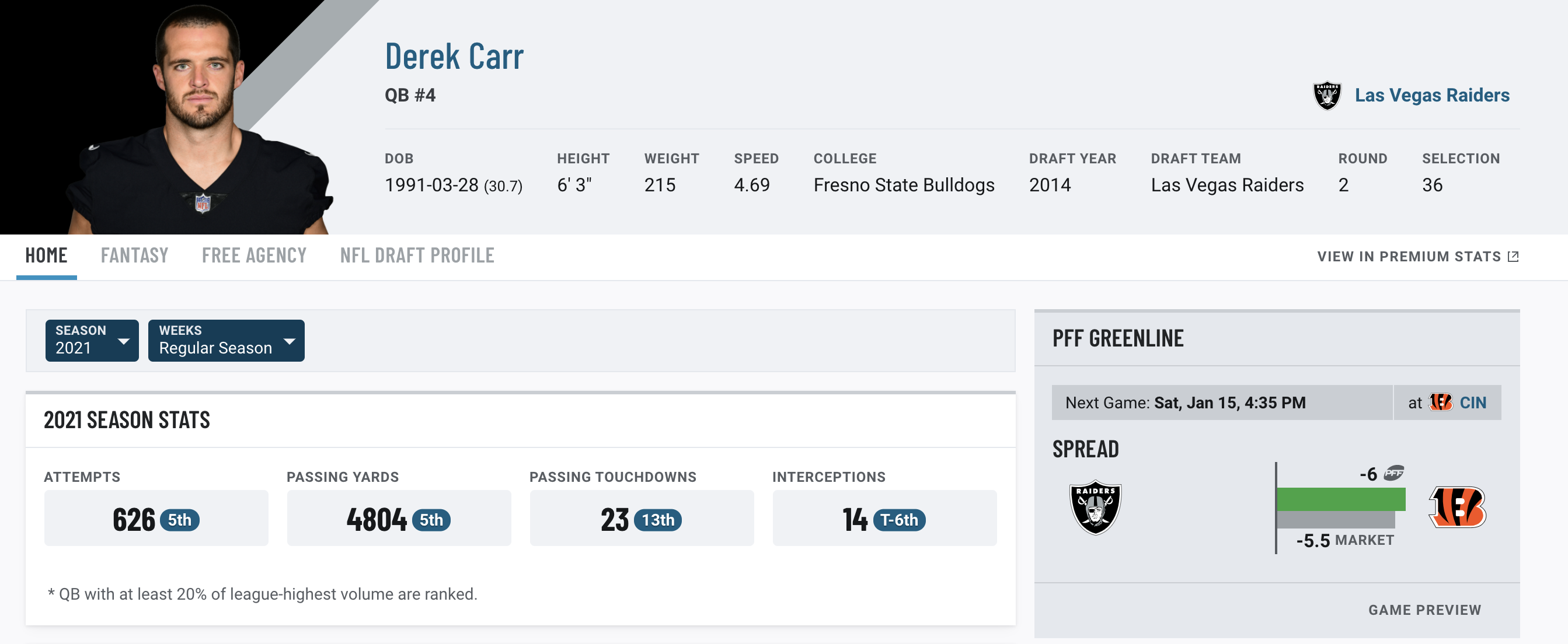
Biggest offensive weakness: This offensive line finished as PFF’s 29th- and 22nd-ranked unit in run- and pass-blocking grade. Carr was pressured at the league’s 19th-highest rate, which is bad, but this group was even worse in quick pressure rate (23rd), measuring an offensive line’s performance when the ball is released in 2.5 or fewer seconds.
Biggest defensive strength: Maxx Crosby racked up a league-high 101 pressures in 2021, providing this pass defense with a constant issue for opposing offenses to deal with all year long. Still, the real strength of this defense was the group’s ability to not give up extra yards, as they ranked ninth in yards after contact per carry and first in yards after the catch allowed per reception.
Biggest defensive weakness: The Raiders generally struggled to limit opposing rushing attacks, ranking 24th in PFF’s team run-defense grade. Only the Seahawks and Jets were worse against opposing backfields in fantasy points allowed per game; the league’s 26th-ranked scoring defense can be had on the ground by the right opponent.
No. 11: Arizona Cardinals
Biggest offensive strength: Kyler Murray’s third-year boom has somewhat gone under the radar due to the Cardinals’ second-half struggles; just realize the 2019 NFL Draft’s No. 1 overall pick was the league’s best quarterback in terms of consistently making high-level throws while limiting mistakes.
Big-time throw rate vs. turnover-worthy play rate in 2021 (min. 250 dropbacks, PFF) pic.twitter.com/QwKYRb0Xzn
— Ian Hartitz (@Ihartitz) January 10, 2022
Biggest offensive weakness: The likes of James Conner and Chase Edmonds put on some fantasy-friendly performances throughout the season when able to dominate volume, but this rushing attack ranked just 27th in PFF rushing grade as a whole. Only the Chiefs and Dolphins averaged fewer yards after contact per carry; don’t expect the Cardinals to pick up many more yards on the ground than whatever is blocked.
Biggest defensive strength: This pass defense finished the season as a top-12 unit in EPA allowed per pass play (No. 12), yards per attempt (No. 10) and explosive pass play rate (No. 5). Having a blue-chip talent like Chandler Jones (PFF’s fifth-highest-graded edge in pass-rush grade) patrolling the line of scrimmage will help do that for ya, and things only figure to get better with J.J. Watt tentatively expected to return to action Monday night.
Biggest defensive weakness: Literally nobody was worse than the Cardinals in yards allowed after contact per carry. This resulted in more than a few big performances on the ground by opposing running backs throughout the season:
- Rashaad Penny: 23 carries-190 rush yards-1 TD
- Dalvin Cook: 22-131-0
- Craig Reynolds: 26-112-0
- Jonathan Taylor: 27-108-0
- Christian McCaffrey: 13-95-0
- David Montgomery: 21-90-1
No. 12: Tennessee Titans
Biggest offensive strength: Derrick Henry and the Titans’ rushing attack is easily the strength of this offense. Credit to D’Onta Foreman for filling in admirably, but there was a night and day difference for this group in terms of overall efficiency with and without King Henry:
| EPA/Play | Overall | Pass | Run |
| With Henry | 0.037 (No. 8) | 0.071 (No. 15) | -0.003 (No. 2) |
| Without Henry | -0.076 (No. 19) | -0.013 (No. 17) | -0.143 (No. 25) |
Biggest offensive weakness: The Titans’ group of big uglies ranked 10th in run-blocking grade but just 28th in pass-blocking grade. This coincided with the group allowing the third-highest pressure rate in the league; only the Falcons and Dolphins were worse. Of course, not having A.J. Brown and Julio Jones for large chunks of the season didn’t help Ryan Tannehill get the ball out faster; either way, this was the league’s fourth-worst offense in pressure rate allowed even when the ball was released in fewer than 2.5 seconds.
Biggest defensive strength: The Titans fielded the league’s fifth-best defense in both yards before contact per carry and explosive run play rate allowed. The Cardinals, Jaguars and Patriots were the only three offenses to clear 100 yards on the ground against this group all season long.
Biggest defensive weakness: This unit came in as just the 16th-ranked defense in havoc. Credit to interior defender Jeffery Simmons (PFF’s 21st-highest graded interior defender pass rusher), while Harold Landry’s 64 pressures were tied for the 12th-most in the NFL. Still, they ranked just 22nd in overall pressure rate and just 26th in quick pressure rate.
No. 13: Kansas City Chiefs
Biggest offensive strength: Sometimes offensive line performance is more of a reflection on the quarterback/scheme; either way, you’d be hard pressed to find a metric that paints this group as anything other than a top-10 unit. Overall, the Chiefs offensive line posted top-10 marks in run-blocking grade (No. 4), pass-blocking grade (No. 6), yards before contact per carry (No. 3) and pressure rate allowed (No. 6).
Biggest offensive weakness: Literally nobody averaged fewer yards after contact per carry than the Chiefs this season. It’s tough to see this rushing attack making a meaningful step forward with banged up versions of Darrel Williams (toe) and Clyde Edwards-Helaire (shoulder); here’s to hoping the latter back is ready for some playoff football after looking awfully impressive against this very Steelers defense prior to originally suffering his current injury.
Okay CEH okay pic.twitter.com/KBcoXd7OiR
— Ian Hartitz (@Ihartitz) December 27, 2021
Biggest defensive strength: The Chiefs come in as the league’s ninth-best defense in havoc, thanks in large part to the excellence of Chris Jones, PFF’s sixth-highest-graded interior defender. It’s also worth noting this group as a whole improved mightily after adding Melvin Ingram to the equation. Overall, the Chiefs allowed more than 30 points in five of their first eight games but just once from Week 9 on.
Biggest defensive weakness: It’s understandable to devote more resources to the pass than the run in the year 2021, but the Chiefs' inability to stop the run could be problematic if they draw the wrong matchup down the stretch. They posted mediocre ranks in yards before contact (No. 27), PFF run defense (No. 26) and EPA allowed per run play (No. 28) alike. This was one of just six defenses to post an average tackle depth of at least 4.5 yards:
- Texans (4.59 average depth of tackle)
- Steelers (4.57)
- Vikings (4.56)
- Chiefs (4.53)
- Cowboys (4.53)
- Chargers (4.50)
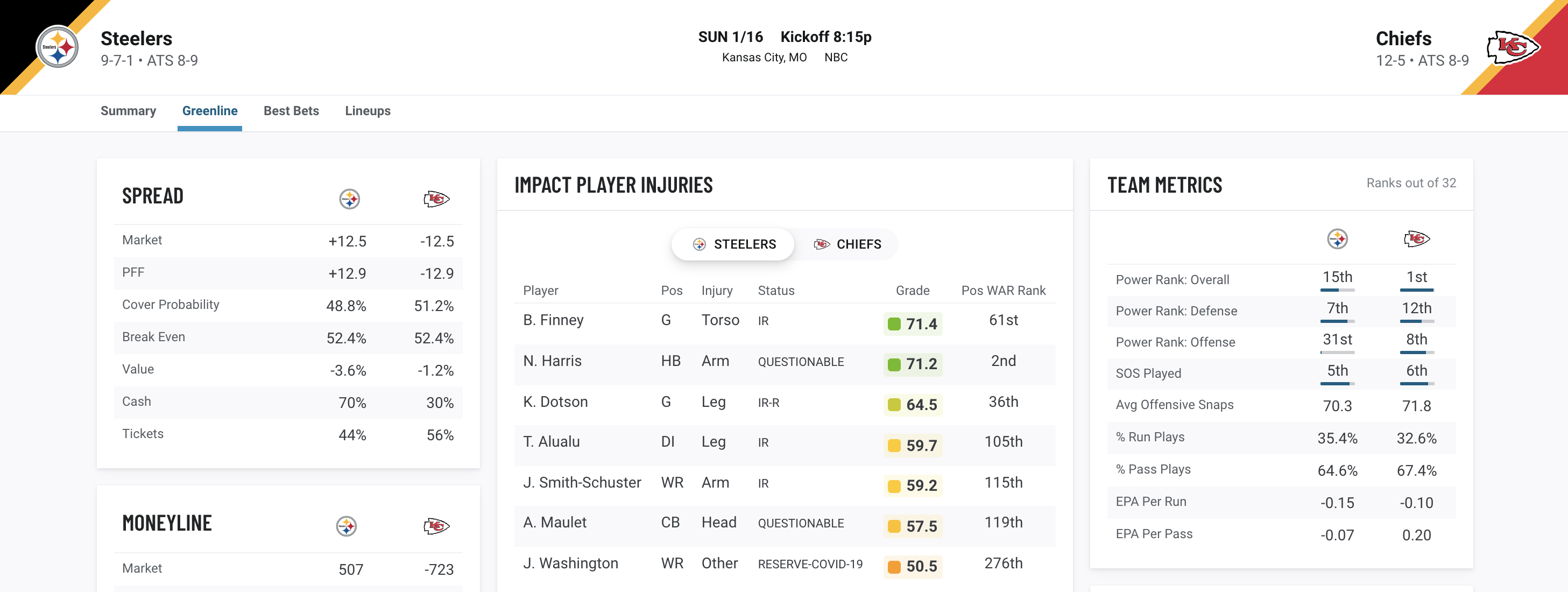
No. 14: Pittsburgh Steelers
Biggest offensive strength: The numbers paint out the Steelers’ offensive line as the “strength” of this team, but even then we’re talking about a below-average unit. The primary reason why Pittsburgh ranks as highly as it does comes down to allowing just the third-highest pressure rate on the season. Unfortunately, this is largely due to Ben Roethlisberger’s league-low 2.26 average time to throw. Getting the ball out quickly isn’t always a bad thing, but nobody had a higher percentage of their passes wind up short of the sticks (62%) than Big Ben this season.
Nobody:
Absolutely no one:
Not a single soul on Earth:
Ben Roethlisberger on 4th down: pic.twitter.com/kwkxQKGwr9
— Ian Hartitz (@Ihartitz) October 4, 2021
Biggest offensive weakness: Pick a stat, any stat, and Roethlisberger is probably among the league’s worst quarterbacks in it:
- PFF passing grade: 55.6 (No. 40 among 44 quarterbacks with at least 100 dropbacks)
- QB rating: 86.8 (No. 28)
- Yards per attempt: 6.2 (No. 37)
- Adjusted completion rate: 72.7% (No. 32)
- Big-time throw rate: 3.3% (No. 28)
- Turnover-worthy play rate: 4.8% (No. 38)
Big Ben has been consistently inaccurate while combining an inability to make “elite” tight-window throws with a bad habit of putting the ball in harm’s way. Other than that, he’s been great.
Biggest defensive strength: T.J. Watt and company certainly proved capable of creating a lot of havoc from time to time; just realize even then we’re talking about a below-average pass rush. Overall, Pittsburgh ranked just 20th in pressure rate and 14th when the quarterback got rid of the ball in under 2.5 seconds. Hardly a bottom of the barrel group, but this isn’t your usual pressure-happy steel curtain.
Biggest defensive weakness: The Steelers’ league-worst defense in yards before contact per rush allowed six separate running backs to go off for 100-plus yards on the ground throughout the season:
- Dalvin Cook: 27 carries-205 rush yards-2 TD
- Joe Mixon: 28-165-2
- Latavius Murray: 16-150-1
- D’Andre Swift: 33-130-0
- D’Onta Foreman: 22-108-0
- Alex Collins: 20-101-1


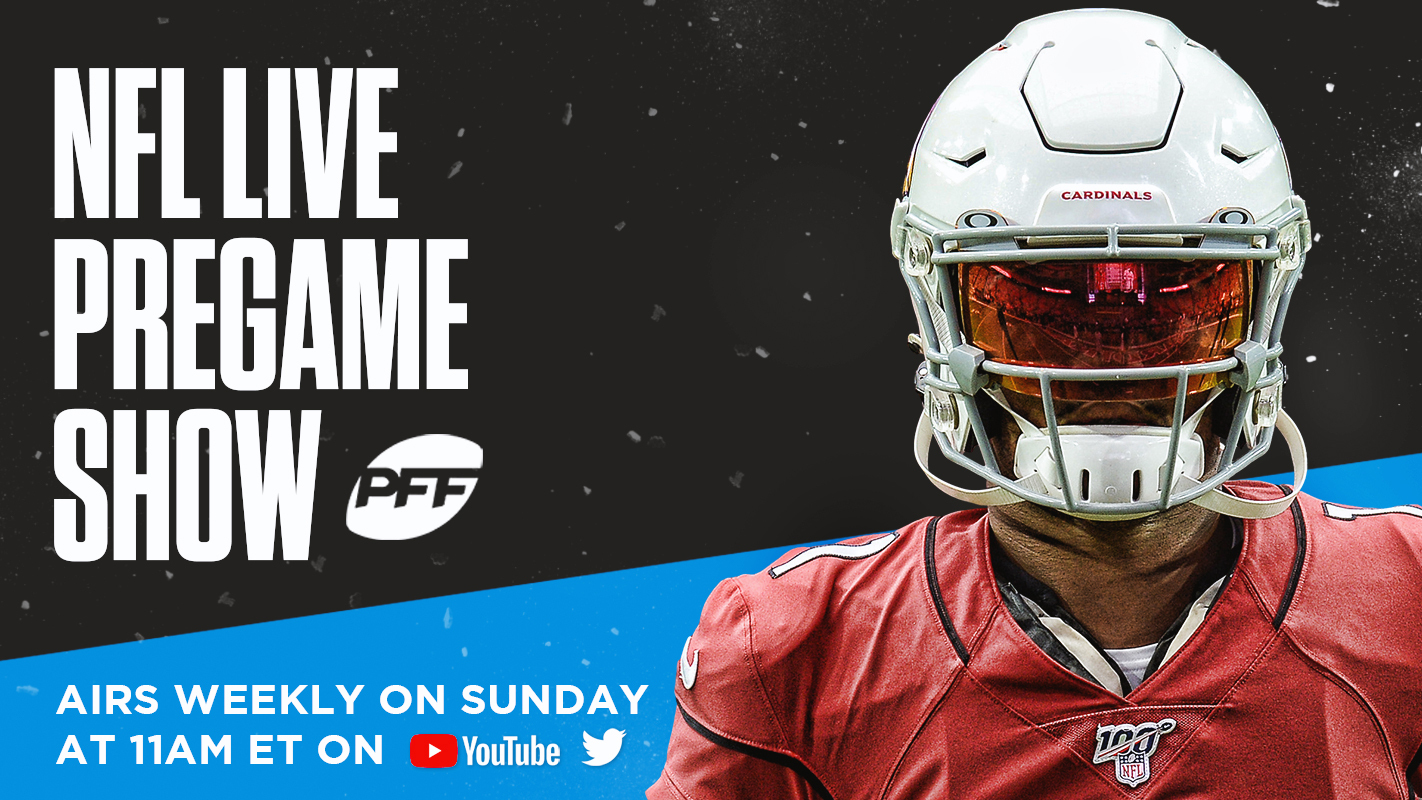


 © 2025 PFF - all rights reserved.
© 2025 PFF - all rights reserved.